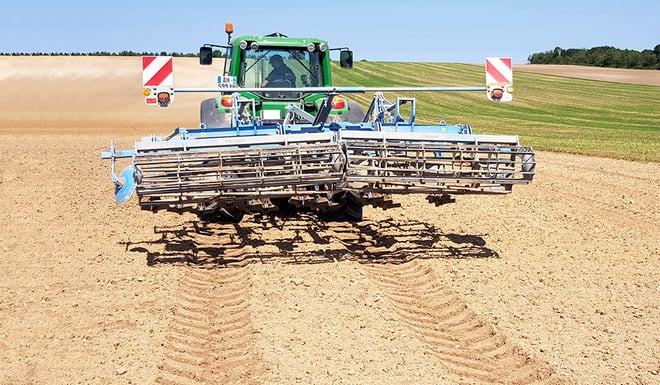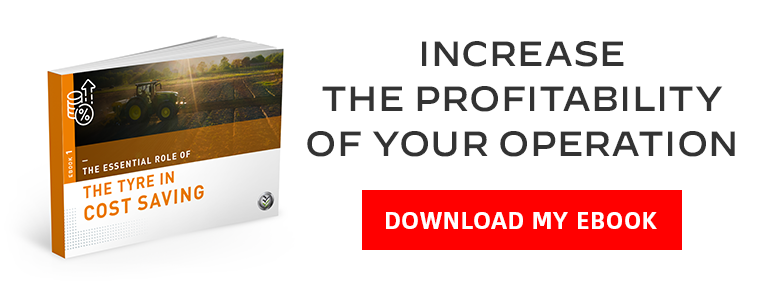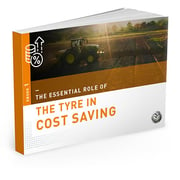When you compare different agricultural tyre models with the same dimensions, you don’t get the same soil footprint or the same work results. The impact of the tyres on soil compaction is different, slip may be correct or excessive, traction may be low or powerful…
While it is difficult to gauge the quality of an agricultural tyre simply by looking at it, a lot can be learned by rapidly analysing your tractor’s tyre footprint. Does it have a large or narrow, deep or superficial footprint? Is it clearly defined or blurry?
In short, your soil footprint shows an important part of the impact that your machine will have on the quality of work that you can carry out with your agricultural tyres.
In this article we look at the benefits of having a wider, longer tractor tyre footprint.
1. Where does the interest in having a wider, longer tyre footprint lie?
The shape, the width and the depth of the soil footprint represent the visible part of your machine’s load.
A deep, narrow footprint reflects excess compaction. This may be due to the soil being too soft or damp to carry the weight of your trailer, or to excess load, which you compensate for by overinflating your tyres.
The wider the tyre footprint, the more evenly the weight is spread
A wide tyre footprint means that the load is spread over a larger surface area, avoiding a concentration of the pressure to the ground.
The weight distribution beneath the footprint is more even depending on the size, of course, but also depending on the tyre technology and the amount of inflation pressure.
This balanced distribution of weight over a larger contact patch with the ground limits compaction, thus preserving the soil’s structure and its production capacity.
A wider tyre footprint is protective of soil fertility
The fertility of the soil is essential for crop growth. Compacted soil loses its capacity to supply nutrients to the plants and enable sufficient root development.
A wider, thus shallower footprint is the sign of a better distribution of the load to the ground. This protects the soil structure, maintaining the porosity necessary for drainage and good development of the roots which penetrate deeper down and are more spread out.
Healthy roots that are well structured in the arable layer of soil absorb nutrients and water better, which encourages rigorous crop growth.
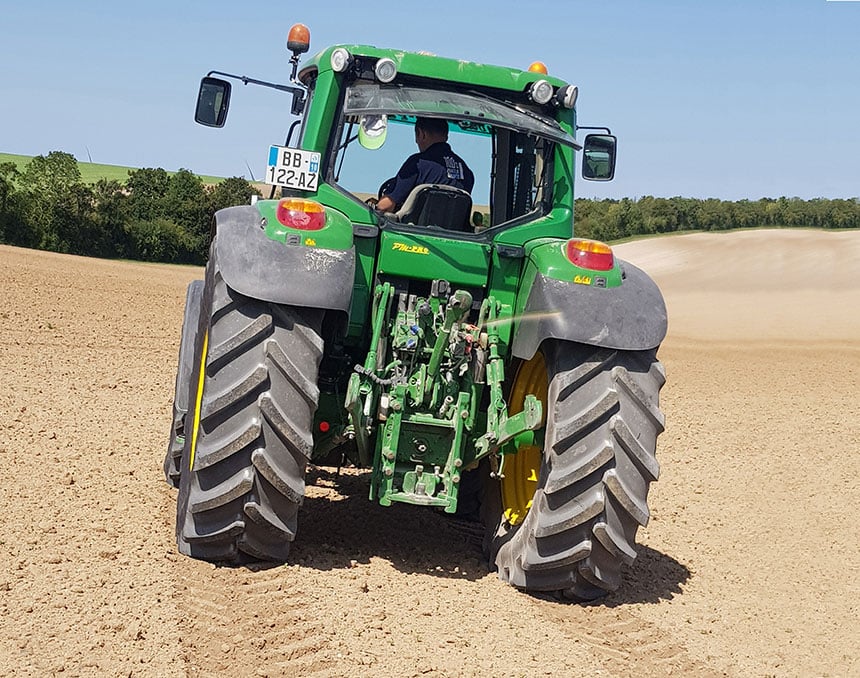
2. A wider, longer tyre footprint gives you more traction
A wider, clearly defined soil footprint is a sign of efficient traction and good grip. This is a very simple way of telling that the engine power is being correctly transmitted to the ground.
Relationship between the contact patch with the ground and traction
The transmission of power to the ground is directly linked to the tyres’ contact patch with the ground.
A wider soil footprint is a sign of a tread with more grip. This provides better adherence for optimal traction, which will be essential if you work in difficult weather conditions, on soft or wet ground.
When your tractor tyres leave a wide footprint, it is because they grip onto the ground better. This leads to more efficient traction, allowing you to move forward more easily and maintain a constant working speed.
A larger bearing surface
A longer tyre footprint offers a larger bearing surface for more lugs, which will be highly beneficial if you work with a heavy, powerful tractor and large scale implements.
The advantages of better traction
Not all your machine’s power is devoted to tractive force, part is required for the mechanical functioning of the tractor.
Another part of around 20% to 35% is absorbed at the level of the tyres, either by rolling resistance or by slippage.
With a longer, wider contact patch with the ground, you will rebalance these percentages, increase work efficiency, reduce fuel consumption and extend the working life of your tyres.
3. If your soil footprint is wide enough, this reduces slip
A minimum amount of slip is absolutely necessary to allow your combination vehicle to move around correctly. With a tread that has a bigger soil footprint, your rolling resistance will decrease as well as the slip ratio.
When the tyres have a bigger grip surface, they have optimal adherence and can transfer more engine power horizontally to the ground.
As a result, the tyre sinks into the ground less, which limits rolling resistance.
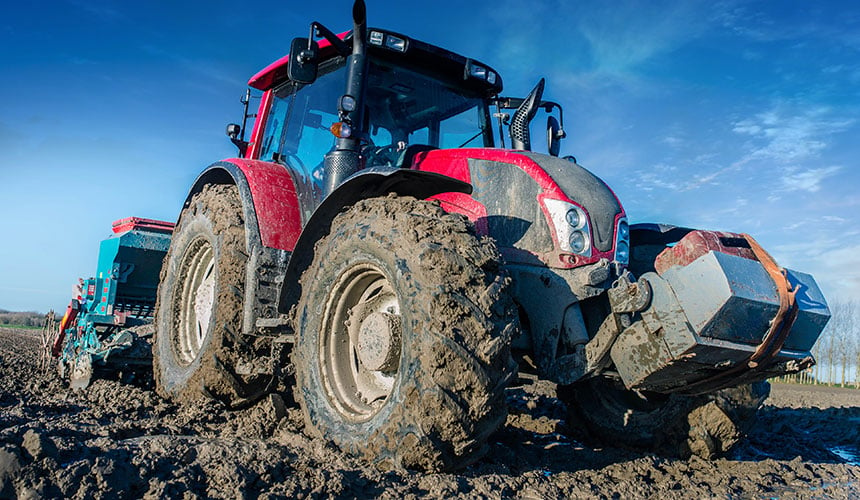
A better hold on the ground to counter slip
Excess slip occurs when the tractor wheels slip on the ground rather than gripping hold of it.
A correct slip ratio is between 8% and 15%, depending on working periods and the type of soil. A slip ratio of above 15% will lead to loss of time and efficiency during your campaigns, not to mention premature wear to the tyres.
A sufficiently large contact area with the ground makes it possible to avoid these drawbacks and improve your productivity, while protecting the fertile layer of soil.
4. What is the impact of pressure on the width and length of the tyre footprint?
La pression a un impact significatif sur la forme de l’empreinte au sol, et comprendre cet impact est essentiel pour maximiser les performances de vos pneus de tracteur.
En effet, une différence de pression peut modifier complètement le comportement de votre tracteur sur le chantier.
Avec trop de pression, le pneu aura tendance à patiner, il accrochera moins au sol, vous perdrez du temps, avec une qualité de traction moyenne et sur sol meuble, ou en conditions humides, vous aurez tendance à créer des ornières et donc provoquer une compaction des sols.
Reduce pressure to increase the size of the footprint
When you reduce the pressure in the tyres, the soil footprint gets bigger. This means that the tyres flatten out more on the surface, creating a bigger footprint.
The increase in the size of the contact patch with the ground is beneficial because it reduces the pressure exerted on the ground by the tyres.
Less pressure means less soil compaction, which is essential to protect the structure and fertility of your land.
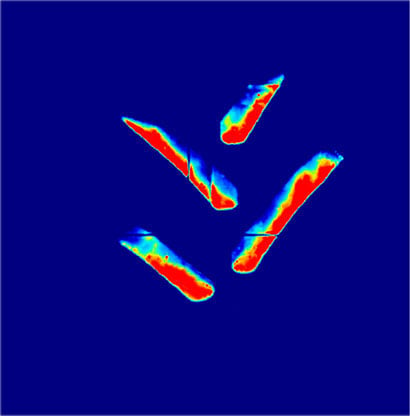
|

|
The red zones represent maximum pressure to the ground
The depth, length and width of the footprint
The soil footprint has three important dimensions: depth, length and width. The depth is linked to the compaction force exerted vertically by the tyres.
- The deeper the footprint, the greater the pressure to the ground.
- On the other hand, a wider, longer and shallower footprint leads to an even distribution of the tractor weight, thus minimising pressure to the ground.
The particularity of the length of the soil footprint
The length of the soil footprint is not as visible as the width, yet it plays an essential role in adherence and the tyre’s traction capacity.
The footprint length merges into the trace left by the tyres, but ensures a better distribution of the tractor’s weight.
A longer soil footprint means that you have more lugs in contact with the ground at the same time, which boosts the tyre’s capacity to transmit force horizontally.
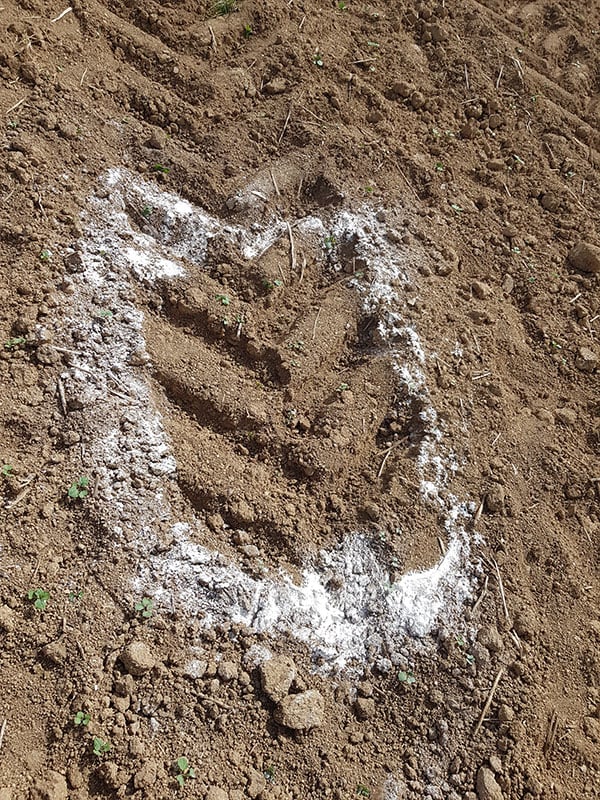
with a low inflation pressure
5. The VX-R TRACTOR tread width is the same as its section width
If you have understood the interest in having a wider footprint to protect your soil, you should know that Bridgestone has developed a high-tech range of tyres which take into account this important feature.
The structure of the VX-R TRACTOR tyre casing has been redesigned so that its tread has a wider ground contact area.
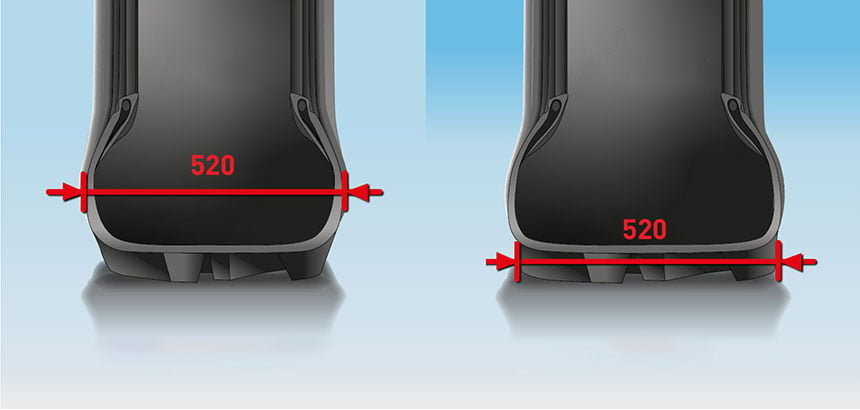
corresponds to the area in contact with the ground,
unlike for the standard tyre on the left
Its robust casing, its premium tread and the higher volume of rubber mean that the VX-R TRACTOR tyre has a section width in contact with the ground that is exactly equal to the section width indicated on the sidewall. Which is never the case with other agricultural tyre models.

soil footprint is the same as its section width
Furthermore, the VX-R TRACTOR tyre has “Involute” lugs patented by Bridgestone which make it possible to transmit more horizontal traction force to the ground.
Thanks to this innovative design, this tyre offers much better traction, great stability and significantly reduces slip and soil disturbance, whatever the type of ground, even on sloping land or in wet conditions.
Whatever the brand of tyre fitted on your tractor, a wider and longer soil footprint (for the same size of tyre) improves the efficiency of your work.
The choice of tyre model is very important and has a positive or negative impact on your yields, based on the quality of the tyre and its ability to work with a larger contact patch with the ground.
The Bridgestone-agriculture.eu blog is written and administered by tractor tyre experts who are available to provide you with the advice you need on the subject of your agricultural tyres. They allow you to maximise your productivity with information on all subjects linked to tyres: Cheap tractor tyres — Technical data for agricultural tyres — Air pressure advice — Solutions to avoid soil compaction — Sprayer tyre pressure — Why and how to ballast your tractor tyres — When to use dual wheels — The mechanical causes of abnormal wear — Cheap agricultural tyres – etc.
To learn more and boost your farm's profits, Bridgestone-Agriculture is offering you a free, detailed white paper that explains the essential role your agricultural tyres play in your productivity.
Most people who read this article have also read some of the following articles:
- 5 essential techniques to optimise your agricultural tyres
- Which agricultural tyre makes it possible to avoid coming off the rim at low pressure?
- What is the impact of implement settings on tractor tyres?
- Fleet audit: what is the main benefit of agricultural tyres?
- Do you really use the full capacity of your VF agricultural tyres?
- Agricultural tyres: rules for managing the lead ratio
- Managing the load transfer to the front tyres in polycropping
- What are the signs of an incorrect lead ratio?
- Impact of the dynamic rolling circumference of agricultural tyres
- What is the impact of the section width of your agricultural tyres
This information is intended only to make you aware of the technical and functional aspects of agricultural tires and their use. It does not allow you to make a judgment or a definitive conclusion on a given problem. Only your agricultural tire expert is able to make a technical assessment and take a final decision, case by case.
Leave a
commentary
Your email address will not be published.
Required fields are indicated with *


